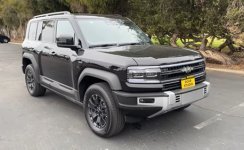| Spec/Feature | Details |
|---|---|
| Brand | Fangchengbao (a BYD sub-brand) |
| Class | Midsize off-road SUV |
| Powertrain | Plug-in hybrid (PHEV) with dual motors |
| Output | ~670 hp combined (reports vary) |
| Electric Range | ~125 km (CLTC) electric-only |
| Chassis | Ladder-frame construction (like Toyota Land Cruiser) |
| Suspension | Air suspension with adjustable ride height |
| Drivetrain | Intelligent AWD with locking diffs (claimed) |
| Interior | Futuristic design with multiple large screens |
| Off-Road Features | Tank turn, trail camera system, adaptive terrain response |
| Price (in China) | Roughly $40,000–$50,000 USD equivalent |
 What's Cool & Quirky?
What's Cool & Quirky?
 1. Electrified Off-Road Power
1. Electrified Off-Road Power
- It’s a PHEV, but still has rugged credentials — combining battery power with an ICE backup, similar in concept to the Jeep Grand Cherokee 4xe or Land Rover Defender PHEV.
- Reportedly does 0–60 mph in around 4 seconds, which is wild for an off-roader.
 2. Real Off-Road Capabilities
2. Real Off-Road Capabilities
- Ladder frame, locking diffs, and air suspension are serious features usually found in hardcore rigs like the Mercedes G-Wagen or Land Cruiser.
- Claims of tank turn and adaptive terrain modes echo features found in Rivian or modern Land Rovers.
 3. Funky, Tech-Heavy Interior
3. Funky, Tech-Heavy Interior
- Expect multiple large infotainment screens, a fighter-jet style shifter, ambient lighting, and full digital integration — very sci-fi compared to traditional off-road interiors.
- Retro-exterior + futuristic interior = strange but cool combo.

 Any Downsides?
Any Downsides?
- Not confirmed for global markets yet — mostly China for now.
- Unknown long-term reliability or serviceability outside of Asia.
- While it looks off-road ready, we’ll need real-world tests to verify if it can hang with vehicles like the Ford Bronco, Land Cruiser 250, or Wrangler Rubicon on tough trails.
 Final Take
Final Take
The Fangchengbao Leopard 5 is a bold statement from China’s growing off-road and EV scene. It's a mashup of off-road tech, luxury SUV flair, and electric performance, wrapped in a boxy, Defender-esque body. If it holds up to the claims, it could disrupt the segment — especially if exported competitively to markets like the Middle East, South America, or eventually North America.
